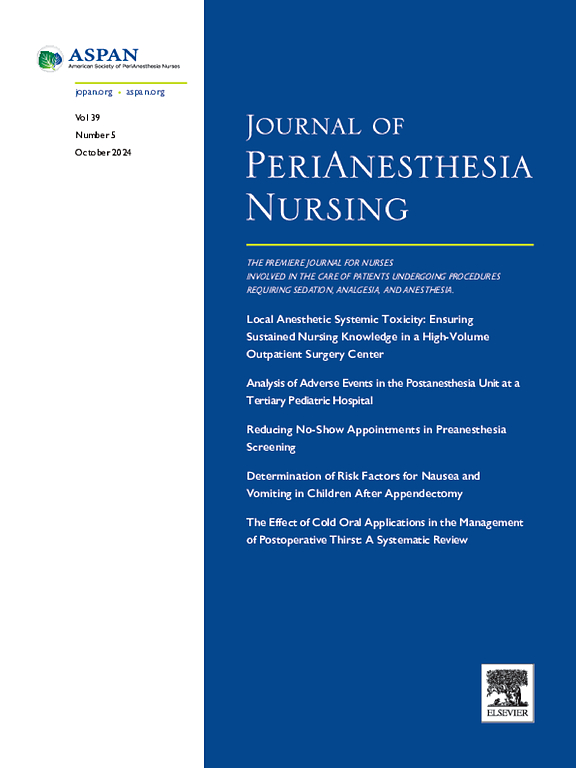Reducing Pain With IV Insertion Using a Needleless Anesthetic Device in the Pediatric Ambulatory Surgery Unit
IF 2
4区 医学
Q2 NURSING
引用次数: 0
Abstract
Purpose
To reduce pain scores with intravenous (IV) insertion by 50% over 2 months among children in the ambulatory surgery center within a pediatric academic hospital.
Design
Evidence-based quality improvement project.
Methods
The project was implemented on a pediatric ambulatory surgery unit within a large, urban pediatric academic hospital. Interventions included implementing an evidence-based needleless anesthetic (J-Tip) with 1% buffered lidocaine. The team collected baseline data based on the standard unit practice before implementation. Our primary outcome was the mean pain scores during IV insertions for children receiving a peripheral IV for ambulatory surgery, and our secondary outcomes were pain scores with the application of the anesthetics and the number of IV attempts. This was carried out through practice changes implemented in Plan-Do-Study-Act (PDSA) cycles.
Findings
Mean pain scores decreased by 72%. This was a statistically significant improvement (P < .05) from baseline (x̄ = 5.3) to post intervention (x̄ = 1.5). We found a slight decrease in IV attempts in the intervention group, from 1.47 to 1.35.
Conclusions
This quality improvement project significantly enhanced the quality of care for pediatric patients in the ambulatory surgery unit by effectively decreasing pain associated with IV insertions. By implementing evidence-based strategies such as needleless anesthetic devices, perianesthesia nurses can minimize pain and create a less intimidating environment for pediatric patients.
在儿科门诊外科使用无针麻醉装置减少静脉注射疼痛。
目的:在一家儿科学术医院的门诊手术中心,通过静脉(IV)插入使儿童的疼痛评分在2个月内降低50%。设计:循证质量改进项目。方法:本项目在某大型城市儿科专科医院的儿科门诊外科实施。干预措施包括使用1%缓冲利多卡因实施循证无针麻醉(J-Tip)。团队在实现之前根据标准单元实践收集基线数据。我们的主要结果是接受门诊手术外周静脉注射的儿童在静脉注射期间的平均疼痛评分,我们的次要结果是使用麻醉剂和静脉注射次数的疼痛评分。这是通过在计划-执行-研究-行动(PDSA)周期中实施的实践变化来实现的。结果:平均疼痛评分下降72%。结论:该质量改进项目通过有效减少静脉注射相关的疼痛,显著提高了门诊外科儿科患者的护理质量。通过实施循证策略,如无针麻醉装置,围麻醉护士可以最大限度地减少疼痛,并为儿科患者创造一个不那么吓人的环境。
本文章由计算机程序翻译,如有差异,请以英文原文为准。
求助全文
约1分钟内获得全文
求助全文
来源期刊

Journal of Perianesthesia Nursing
NURSING-
CiteScore
2.20
自引率
17.60%
发文量
279
审稿时长
90 days
期刊介绍:
The Journal of PeriAnesthesia Nursing provides original, peer-reviewed research for a primary audience that includes nurses in perianesthesia settings, including ambulatory surgery, preadmission testing, postanesthesia care (Phases I and II), extended observation, and pain management. The Journal provides a forum for sharing professional knowledge and experience relating to management, ethics, legislation, research, and other aspects of perianesthesia nursing.
 求助内容:
求助内容: 应助结果提醒方式:
应助结果提醒方式:


